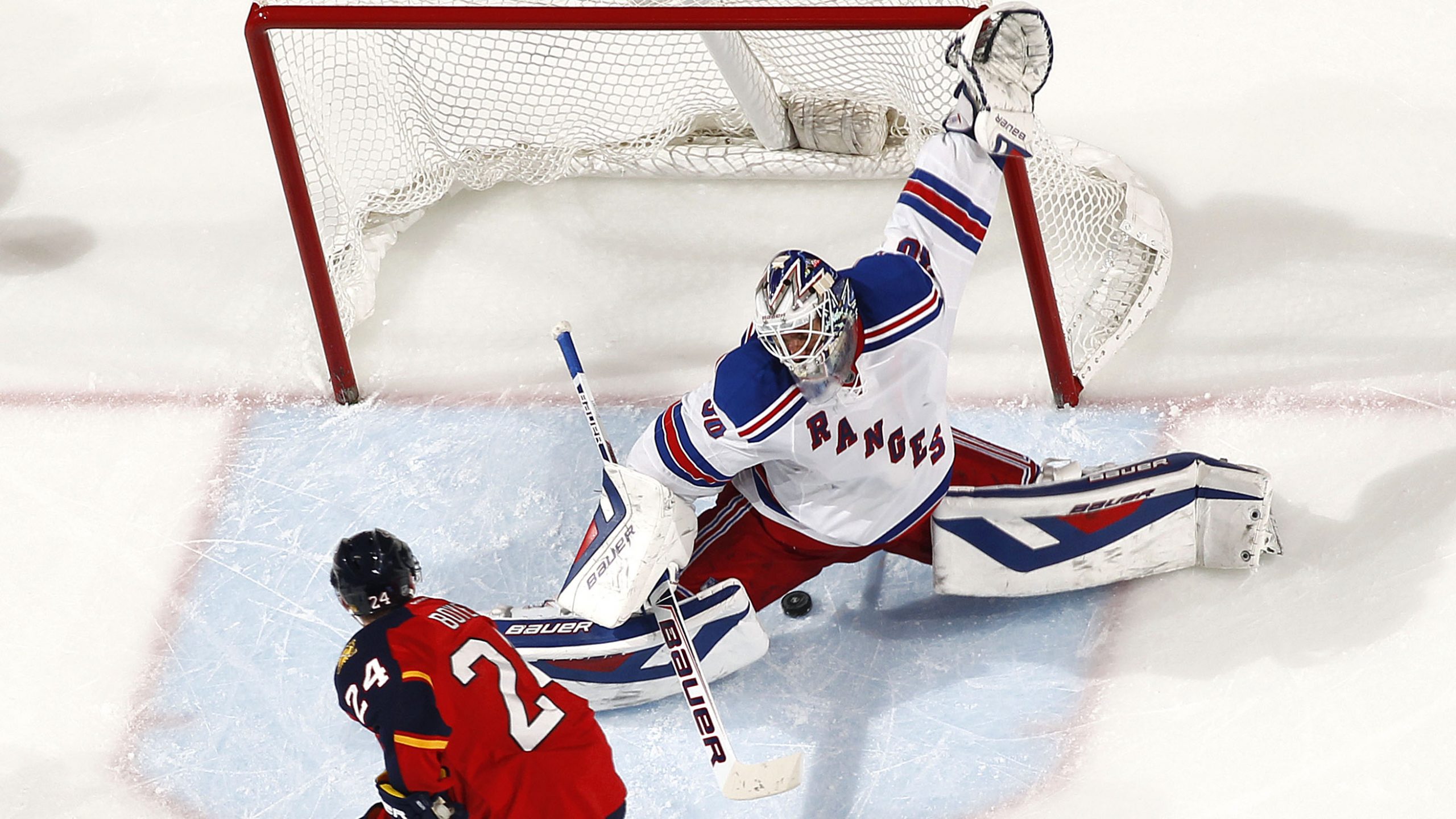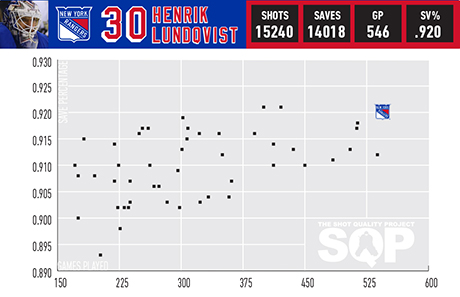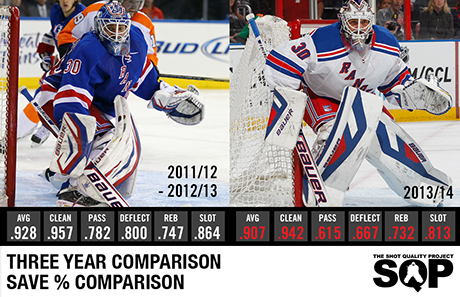What is wrong with the King?
The best goaltender in the NHL since the 2004-05 lockout has been Henrik Lundqvist. He has been consistently among the league leaders in all categories while maintaining a starter’s workload for his whole career. The Rangers pencil him in for 80 percent of their games and have received Vezina Trophy-level goaltending for close to a decade. Since his debut in 2005-06, Lundqvist trails only Tim Thomas and Tomas Vokoun in overall save percentage—by .001.
(minimum 5,000 shots faced)
Lundqvist has never registered a full season under the NHL average save percentage, a consistency that is hard to match among current NHL starters. When I created an expected save percentage for an average goaltender during his career span Lundqvist was 150 goals better.
One of the keys to his success is the style he plays. He arrived in the NHL playing a more conventional outside-in style—he set up outside his crease and would retreat backward. But under the influence of Benoit Allaire, he adapted to a deeper game. There are other disciples of Allaire (Canadian Olympian Mike Smith for one), but none have implemented his teachings as successfully. Lundqvist’s mental game is just as important. He relies heavily on his ability to read the puck off the stick and anticipate the play. He is also extremely patient, which allows him to remain on his feet for pucks targeted high.
Playing deep allows for better crease containment. This lets Lundqvist take shorter routes to lateral feeds while also maintaining a reasonable distance to react to deflections and redirections. It is amazing how often he remains in contact with his posts. This containment was reflected in his numbers in the shot quality project.
Through close to 3,000 shots measured from the 2011-12 through the 2012-13 seasons, Lundqvist had a .782 save percentage on transition shots as well as an .800 save percentage on tips.
I tracked his positioning to see where he sets up and illustrated how dedicated he is to staying within the blue paint.
To begin this season, I tracked a 300-shot sample for Lundqvist and Carey Price—the goaltender considered the blueprint for the modern evolution of today’s puckstopper. Ninety-seven percent of Lundqvist’s play was within the crease and 56% of his positioning was on the goal line. He rarely strays outside the blue paint. Contrast that to Carey and we can see just how extreme Lundqvist’s style is.
Where Lundqvist only set-up outside his crease on three percent of his plays, Price sets up outside the comforts of the blue paint on 17 percent and only plays along the goal line on 33 percent. For every 100 shots faced, Lundqvist is on his goal line for 23 extra shots.
Price recently marveled at the success Lundqvist has playing at this depth. Personally I am a fan of the mental dedication and discipline it requires to maintain this style of play, but am concerned how it will age because of the reduced reaction time standing on the goal line. This season Lundqvist’s numbers are down across the board, so I wanted to see if it was a function of a tougher workload. Was he being exposed to higher-quality opportunities? Using the same methodology as my previous studies, I separated his 2012-13 workload from his 2013-14 workload.
As we can see above, Lundqvist has been exposed to more slot opportunities this season. If I take his career average save percentage of .851 on those 44 extra shots, we are left with seven extra goals. That is significant when we realize that Lundqvist has pushed himself up to .910 his past two starts—.910 is .004 below the league average and .917 would place him slightly above. He is also facing a slightly more difficult workload in regards to transition opportunities, leaving even his extreme depth at risk.
Although he is facing three fewer shots this season on lateral feeds, we can see above that they are concentrated in the middle of the slot and considerably closer to the net. This could be an explanation why his lateral save percentage has cratered from an average of .782 to .615 in 2013-14. But he hasn’t been the victim of a defence totally abandoning him. His workload this season has been slightly harder than last, and I can’t quantify how much is because of the change from John Tortorella to Alain Vigneault or the perceived pressure of a new contract. My bet is just random variance and some below-average defensive support have led to the worst statistical stretch of Lundqvist’s career.
The King is only 31 and while I expect that he will regress significantly over the length of his new contract, it isn’t happening yet. Eric Tulsky looked at how he expected Lundqvist to age and we are still years away from a statistical drop off as significant as the one we have seen the first half of the season. I think of this as more of a blip on the radar. Bet on his numbers normalizing to the previous 3,000-shot sample as the season progresses, likely just in time for the Olympics.







